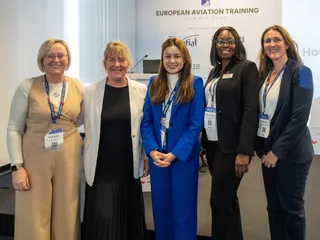FAA Modernization Initiatives: Part 141 Reform and Airman Certification ODA Program
Contact Our Team
For more information about how Halldale can add value to your marketing and promotional campaigns or to discuss event exhibitor and sponsorship opportunities, contact our team to find out more
The Americas -
holly.foster@halldale.com
Rest of World -
jeremy@halldale.com
.jpg/r%5Bwidth%5D=320/b5e63260-4229-11f0-af24-714abd46b0c5-IMG_7688%20(1).webp)
Based on presentations from the WATS Conference, Orlando, April 2024
The Federal Aviation Administration (FAA) is undertaking significant modernization efforts that promise to transform pilot training and certification processes. At the recent WATS conference in Orlando, two key initiatives were presented that highlight the agency's commitment to improving efficiency, safety, and industry collaboration in aviation training.
Part 141 Modernization: A Long-Overdue Reform
Everett Rachon, Manager of the Training and Certification Group at FAA Flight Standards, unveiled the agency's comprehensive Part 141 Modernization initiative—the first major rulemaking effort focused on pilot schools in decades. This ambitious project represents a fundamental shift in how the FAA approaches flight training regulations.
Why Now?
The timing of this initiative is strategic, aligning with other significant FAA modernization efforts, including powered lift rulemaking, advanced air mobility regulations, and the MOSAIC rule. As Rachon explained, "It almost made no sense for us not to have this effort as part of the modernization initiative, especially when you look in light of these other rulemaking activities."
The current Part 141 regulations, while foundational, are acknowledged by the FAA as not being "as efficient and effective as it could be and should be." This modernization effort aims to address long-standing industry concerns while positioning pilot training for future aviation needs.
Core Objectives
The Part 141 modernization initiative focuses on five key areas:
1. Enhanced Safety The primary goal remains increasing safety and reducing the general aviation fatal accident rate. The initiative aims to enhance the flight training environment to produce more proficient pilots.
2. Innovation and Technology Integration Recognizing the rapid advancement in training technologies, including virtual reality (VR) and mixed reality (MR), the FAA aims to ensure that regulations don't inadvertently hinder beneficial innovations. The goal is to encourage, rather than restrict, technological advancements in flight training.
3. Increased Part 141 Participation The initiative aims to make Part 141 certification more attractive to flight schools currently operating under Part 61. By removing barriers and enhancing the regulatory framework, the FAA seeks to encourage more schools to join the Part 141 community.
4. Examining Authority Enhancement. One focal area involves expanding and clarifying examining authority policies, both in the short term through policy updates and in the long term through regulatory changes.
5. Data Sharing and Remote Oversight The initiative emphasizes leveraging technology for real-time data collection and sharing. This could reduce the need for physical FAA inspector visits while maintaining oversight quality through system-based surveillance.
A Unique Approach: Public Meetings Over Traditional Rulemaking
Rather than following the conventional Notice of Proposed Rulemaking (NPRM) process or establishing an Aviation Rulemaking Committee, the FAA chose a series of public meetings. This approach offers several advantages:
- Open Participation: Unlike closed-membership rulemaking committees, these meetings are open to all industry participants
- Flexibility: The format allows for more dynamic discussion and adaptation
- Early Industry Input: Stakeholders can influence the direction before formal rulemaking begins
- Comprehensive Coverage: Eight meetings are planned, combining virtual and in-person formats
The series began with strong participation in March and April 2024, with additional meetings scheduled throughout the year. A final report with industry recommendations is expected within approximately one year.
Airman Certification ODA: Expanding Delegation Authority
Melanie Weddles, Team Lead for the Organization Designation Authorization (ODA) Office, presented the upcoming Airman Certification ODA (ACODA) program—a significant expansion of the FAA's delegation authority that could transform how pilot and mechanic certifications are conducted.
What is ACODA?
The Airman Certification Organization Designation Authorization program represents a shift from managing individual designees to delegating organizational authority. Under this system, qualified organizations would be authorized to conduct specific airman testing on behalf of the FAA, covering both pilot and mechanic certification tests.
System Comparison: Individual vs. Organizational Delegation
The current system relies heavily on individual designees—Designated Pilot Examiners (DPEs), Technical Certification Examiners (TCEs), and others—whom the FAA must individually train, appoint, and oversee. The ODA system delegates these responsibilities to qualified organizations, which then manage their own "unit members" who conduct the actual testing.
Key differences include:
Individual Designee System:
- FAA manages each examiner individually
- Direct FAA oversight of every designee
- Limited flexibility in scheduling and resource allocation
ODA System:
- The organization manages its testing personnel
- FAA conducts system-based oversight
- Greater scheduling flexibility and resource efficiency
- Organizations responsible for training and qualifying their unit members
Potential Benefits
The ACODA program promises several advantages:
Expanded Certification Capability: By adding another option alongside existing individual designees and examining authority, the program could help address scheduling bottlenecks and capacity constraints in the certification system.
Improved Efficiency: Organizations can manage their testing schedules without requiring FAA inspector coordination for every checkride. Weather delays or equipment issues can be resolved internally without requiring complete rescheduling of FAA oversight.
System-Based Oversight: Rather than observing individual checkrides, FAA inspectors can conduct comprehensive surveillance of the entire organization's operation, including training programs, record-keeping, and quality assurance systems.
Resource Optimization: By delegating routine oversight to qualified organizations, FAA inspectors can focus on other safety-critical tasks such as investigations and certificate holder management.
Implementation Timeline
The ACODA program has been in development for several years, with public comment periods completed in 2023. The revised Order 8100.15 (Organization Designation Authorization Procedures) is currently under review for legal sufficiency, with publication projected for summer 2024; however, previous delays make this timeline tentative.
Industry Implications and Future Outlook
Both initiatives represent significant shifts in FAA philosophy toward greater industry collaboration and modernized regulatory approaches. The Part 141 modernization acknowledges that effective regulation requires ongoing input from the industry and adaptation to technological advancements. Similarly, the ACODA program recognizes that delegation to qualified organizations can improve both efficiency and oversight quality.
For Flight Training Organizations
These changes offer substantial opportunities:
- Part 141 schools can influence future regulations through active participation in public meetings
- Part 61 operations may find Part 141 certification more attractive, as barriers are reduced
- Technology companies serving the training market may find fewer regulatory obstacles to innovation
- Organizations with examining capability may benefit from expanded delegation authority
Looking Forward
The success of these initiatives depends heavily on industry participation and feedback. The FAA has made clear that this is not a top-down regulatory effort but a collaborative modernization process. As Rachon emphasized, "This is industry's opportunity to voice some of the challenges that have been experienced on Part 141."
The aviation training community now has an unprecedented opportunity to shape the future of flight training regulation. Active participation in the remaining public meetings and engagement with the ACODA development process could influence aviation training for decades to come.
For those interested in participating, meeting information is available through Federal Register notices and the FAA's Part 141 Modernization website. The aviation community's response to these initiatives will largely determine their ultimate success and impact on the future of pilot training in the United States.


